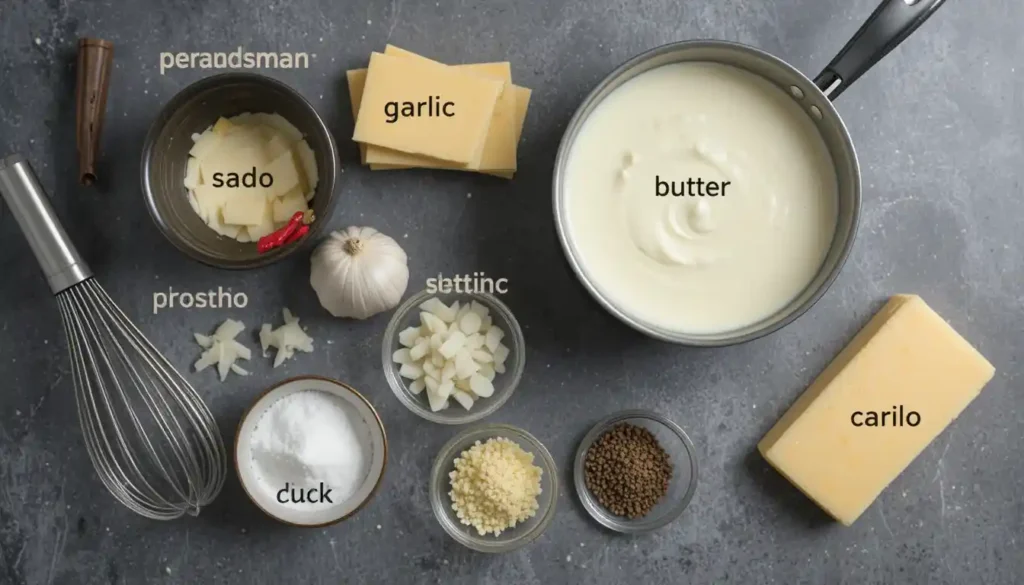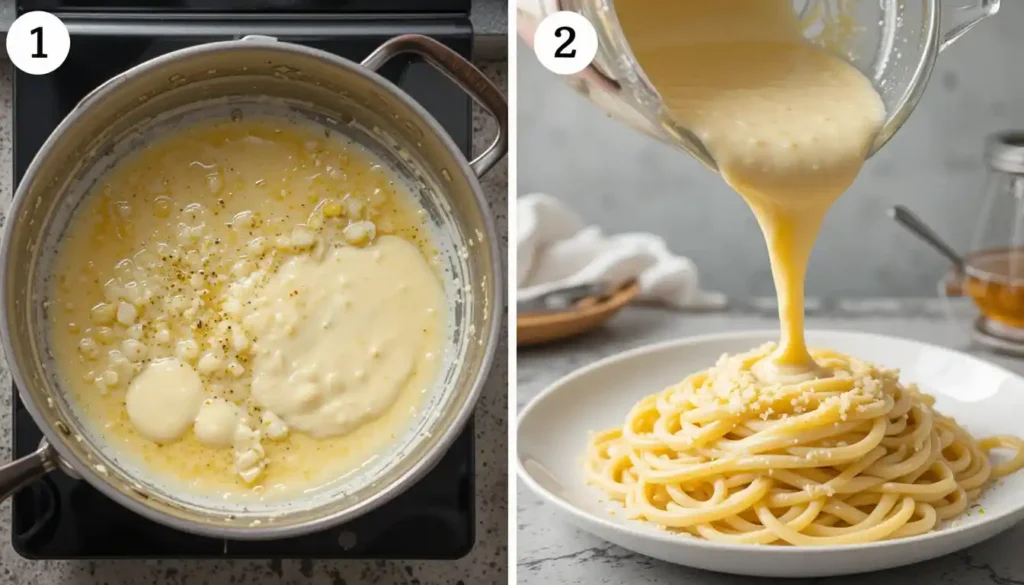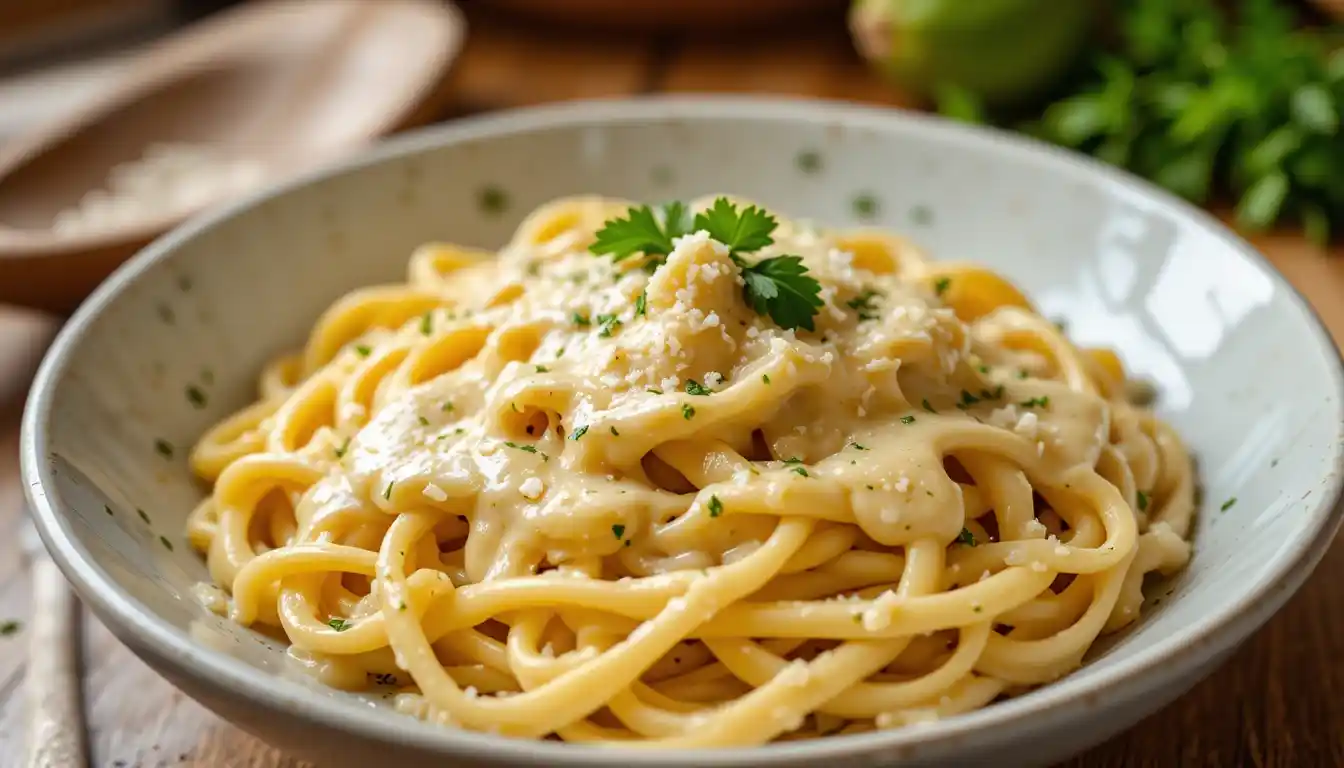Table of Contents
Alfredo Sauce
Rich, creamy, and utterly decadent, Alfredo sauce is a classic addition to any pasta dish, especially lasagna. The secret to a perfect Alfredo sauce lies in its simplicity—just a few ingredients come together to create a velvety, indulgent texture that elevates your meal.
To start, melt butter in a saucepan over medium heat. Once melted, add heavy cream and bring it to a simmer, stirring constantly. The cream should bubble gently without boiling. After a few minutes, reduce the heat and slowly stir in freshly grated Parmesan cheese. Continue stirring until the cheese has fully melted and the sauce is smooth and thickened.
Season the sauce with salt, freshly cracked black pepper, and a pinch of garlic powder or minced garlic for added depth. For extra richness, you can stir in a bit of cream cheese, which will make the sauce even thicker and smoother.

Alfredo sauce pairs beautifully with pasta, but it’s also a great choice for lasagna. Layer it between sheets of noodles for a creamy twist on traditional lasagna, or use it as a base in place of marinara for a luxurious white lasagna. The creamy flavor will surely take your dish to the next level!
What is Alfredo Sauce?
Alfredo sauce is a rich and creamy white sauce made primarily from butter, heavy cream, and Parmesan cheese. Originating in Italy, it was named after Alfredo di Lelio, who created the dish in the early 20th century. Initially, Alfredo sauce was a simple blend of butter and Parmesan, meant to coat fettuccine noodles for a rich, comforting dish. Over time, however, the recipe evolved, with the addition of cream to make it even more decadent and smooth.
The sauce is characterized by its velvety texture and mild, savory flavor, thanks to the combination of creamy dairy and the salty, nutty taste of Parmesan. Garlic, black pepper, and other seasonings are often added to enhance its depth. While traditional Alfredo is typically served with pasta, it can also be used in lasagna, on vegetables, or as a dip.
Though it’s incredibly indulgent, Alfredo sauce is a versatile ingredient that can be modified. For example, you can lighten it by using half-and-half instead of cream, or try adding different cheeses like mozzarella for a slightly different flavor profile.
Whether used in pasta dishes or as a topping, Alfredo sauce offers a creamy, comforting experience that’s perfect for many different meals.
How to Make Alfredo Sauce
Making homemade Alfredo sauce is quick, simple, and results in a creamy, rich sauce that elevates any dish. To begin, melt 1/2 cup (1 stick) of unsalted butter in a medium saucepan over medium heat. Once the butter is melted, add 1 cup of heavy cream and bring the mixture to a simmer. Stir constantly to ensure the cream doesn’t boil over.
Let the cream and butter simmer gently for 3-5 minutes, allowing the mixture to thicken slightly. Next, gradually stir in 1 cup of freshly grated Parmesan cheese, mixing until the cheese is fully melted and the sauce is smooth and creamy. Be sure to use fresh Parmesan for the best texture and flavor—pre-grated versions can affect the sauce’s consistency.
Season the Alfredo sauce with salt, freshly ground black pepper, and a pinch of garlic powder or minced garlic, depending on your taste. For a richer, thicker sauce, you can also stir in 2 oz of cream cheese, which will make the sauce even more velvety.
Once the sauce has thickened to your liking, remove from heat and pour it over your favorite pasta or lasagna. Serve immediately for the best texture and flavor.
Best Homemade Alfredo Sauce
The best homemade Alfredo sauce is rich, velvety, and perfectly balanced in flavor. It’s all about using high-quality ingredients and making the sauce from scratch for an indulgent, creamy result that can’t be beat. Here’s how to make it.
Start by melting 1/2 cup (1 stick) of unsalted butter in a medium saucepan over medium heat. Once the butter is fully melted, add 1 cup of heavy cream and bring the mixture to a simmer. Stir constantly to keep the cream from scorching, allowing it to thicken for about 3–5 minutes.
Next, gradually whisk in 1 cup of freshly grated Parmesan cheese, stirring until the sauce becomes smooth and creamy. Freshly grated cheese is key to achieving that perfect texture—pre-grated varieties can cause the sauce to become grainy. For added depth of flavor, season with salt, freshly cracked black pepper, and a pinch of garlic powder or minced garlic.
For a slightly thicker sauce, you can add 2 oz of cream cheese, which will make the sauce extra rich and smooth. Once the sauce has reached your desired consistency, remove from heat and serve immediately with pasta, lasagna, or roasted vegetables.
Homemade Alfredo sauce is an easy, foolproof way to elevate any meal!
Ingredients
To make the best homemade Alfredo sauce, you’ll need just a few simple, high-quality ingredients that come together to create a rich, creamy sauce. Here’s what you’ll need:

- 1/2 cup unsalted butter – This is the base of your sauce and provides a rich, smooth flavor.
- 1 cup heavy cream – Adds the necessary creaminess and helps create a velvety texture.
- 1 cup freshly grated Parmesan cheese – Freshly grated cheese is key for a smooth sauce with a rich, nutty flavor. Avoid pre-grated Parmesan, as it can lead to a grainy texture.
- Salt – To taste, to enhance the flavors of the sauce.
- Freshly cracked black pepper – Adds a hint of spice and balances the richness of the cream.
- 1/2 teaspoon garlic powder or 1–2 cloves garlic (minced) – Optional, but garlic enhances the depth of flavor in the sauce.
- Optional: 2 oz cream cheese – If you like your Alfredo sauce extra thick and creamy, adding cream cheese is a great option.
These ingredients come together in just a few simple steps to create a sauce that’s perfect for pasta, lasagna, or even drizzled over roasted vegetables.
Instructions

- Melt the Butter
Begin by melting 1/2 cup (1 stick) of unsalted butter in a medium saucepan over medium heat. Stir occasionally to ensure the butter melts evenly, but keep a close eye on it so it doesn’t burn. - Add the Cream
Once the butter is fully melted, pour in 1 cup of heavy cream. Stir the mixture together and bring it to a gentle simmer. Allow it to simmer for 3-5 minutes, stirring frequently. The cream should begin to thicken slightly, but avoid letting it boil to prevent curdling. - Incorporate the Cheese
Gradually whisk in 1 cup of freshly grated Parmesan cheese. Add it a little at a time to ensure it melts smoothly into the sauce without clumping. Stir continuously until the sauce is silky and well-combined. This step is crucial for a smooth, creamy texture. - Season the Sauce
Add salt and freshly cracked black pepper to taste. If you’re using garlic, add 1/2 teaspoon of garlic powder or 1–2 minced cloves of garlic. Stir until the garlic is fully incorporated into the sauce, enhancing its flavor. - Optional Cream Cheese
For an even richer sauce, stir in 2 oz of cream cheese at this point. This will thicken the sauce and make it even creamier. - Serve
Once the sauce reaches your desired consistency, remove it from the heat and serve immediately over pasta, lasagna, or your favorite dish. Enjoy!
Nutrition
Homemade Alfredo sauce is undeniably rich and creamy, but it’s important to be aware of its nutritional content, especially if you’re watching your calorie intake. Here’s an approximate breakdown of the nutrition per serving (based on a recipe that serves 4):
- Calories: 300–350 per serving
- Fat: 28–30 grams
- Saturated Fat: 16–18 grams
- Carbohydrates: 4–6 grams
- Fiber: 0 grams
- Sugar: 1 gram
- Protein: 6–8 grams
- Cholesterol: 80–100 milligrams
- Sodium: 450–500 milligrams
Keep in mind that these values can vary depending on the exact ingredients and portion sizes. For example, if you use low-fat cream, a lower-fat butter substitute, or omit the cream cheese, you can reduce the fat and calorie content. Alternatively, adding extra cheese or cream can increase the richness and the nutritional values.
For those looking to make a lighter version, consider using half-and-half instead of heavy cream, or opting for a plant-based cream alternative and nutritional yeast for a dairy-free option. It’s easy to adjust the recipe to fit your dietary needs without compromising too much on flavor.
Additional Info
Making Alfredo sauce from scratch is not only easy, but it also allows you to control the quality and richness of the ingredients. Unlike store-bought versions, homemade Alfredo sauce is free from preservatives and artificial flavors, giving you a fresh, wholesome alternative.
Storage:
If you have leftovers, store the Alfredo sauce in an airtight container in the refrigerator for up to 3–4 days. When reheating, you may need to add a little extra cream or milk to bring it back to a smooth consistency, as it can thicken when cooled.
Freezing:
Alfredo sauce can be frozen, though it may change texture slightly when thawed. To freeze, let the sauce cool completely, then transfer it to an airtight container or freezer bag. It will keep in the freezer for up to 3 months. When ready to use, thaw overnight in the fridge and gently reheat on the stovetop, adding a bit of cream or milk to help it regain its creamy texture.
Pairing Suggestions:
This Alfredo sauce is perfect with classic pasta dishes like fettuccine Alfredo, but it also pairs well with vegetables like roasted broccoli, cauliflower, or zucchini. You can even use it as a base for a white lasagna or drizzle it over grilled chicken for a comforting meal.
FAQs
1. Can I make Alfredo sauce without heavy cream?
Yes! You can substitute heavy cream with half-and-half, milk, or even a dairy-free alternative like coconut cream or cashew cream. The result will be a lighter sauce but still creamy.
2. How can I make Alfredo sauce thicker?
To thicken Alfredo sauce, you can add more Parmesan cheese, cream cheese, or let it simmer longer until it reaches your desired consistency. You can also thicken it with a small amount of cornstarch or flour, but be sure to cook it through.
3. Can I use pre-grated Parmesan cheese?
While it’s possible, it’s best to use freshly grated Parmesan cheese. Pre-grated cheese often contains anti-caking agents that can affect the sauce’s texture and make it less creamy.
4. Can I make Alfredo sauce ahead of time?
Yes, you can make the sauce ahead of time and store it in the refrigerator for up to 3–4 days. Reheat gently on the stovetop, adding a little milk or cream to bring it back to a smooth consistency.
5. Can I freeze Alfredo sauce?
Alfredo sauce can be frozen for up to 3 months. However, the texture may change slightly when thawed, so be prepared to add some extra cream or milk when reheating.
6. Can I use garlic in Alfredo sauce?
Yes! Garlic is a great addition. You can use garlic powder or fresh garlic for a more robust flavor. Just sauté the minced garlic in butter before adding the cream for a delicious aroma.
7. Is Alfredo sauce gluten-free?
Yes, Alfredo sauce is naturally gluten-free as it doesn’t contain flour or any gluten-containing ingredients. However, be sure to check for any additives in pre-made ingredients if you’re using them.
8. How can I make Alfredo sauce dairy-free?
For a dairy-free version, use plant-based cream (such as coconut or cashew cream) and nutritional yeast instead of Parmesan cheese. You can also substitute dairy-free butter and non-dairy milk for a completely dairy-free Alfredo sauce.
9. Can I add vegetables to Alfredo sauce?
Absolutely! You can mix in roasted vegetables like broccoli, spinach, mushrooms, or zucchini. Adding them will enhance the flavor and make the dish even more nutritious.
10. What’s the best pasta to use with Alfredo sauce?
Traditionally, fettuccine is the pasta of choice for Alfredo sauce, as its broad, flat shape holds the creamy sauce well. However, you can use any pasta you like, such as penne, rigatoni, or even spaghetti.
Conclusion
Homemade Alfredo sauce is a timeless, indulgent recipe that brings richness and flavor to any dish. With just a few simple ingredients—unsalted butter, heavy cream, Parmesan cheese, and seasonings—you can create a velvety, creamy sauce that transforms pasta, lasagna, or roasted vegetables into an unforgettable meal. Whether you’re sticking to the classic recipe or experimenting with variations, this sauce is incredibly versatile and can be adjusted to suit different tastes and dietary preferences.
From adding garlic for an extra layer of flavor to experimenting with lighter alternatives like half-and-half or plant-based creams, Alfredo sauce can easily be tailored to meet your needs. It’s perfect for making ahead of time, storing, or even freezing, ensuring you always have a rich sauce ready to go.
Whether you’re hosting a family dinner, preparing a special occasion meal, or simply craving something comforting, homemade Alfredo sauce is a reliable and delightful addition to your recipe repertoire. With just a little time and a few simple steps, you can create a dish that’s creamy, comforting, and truly satisfying. Enjoy every decadent bite!


2 thoughts on “Best Homemade Alfredo Sauce”
Comments are closed.